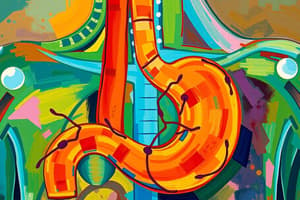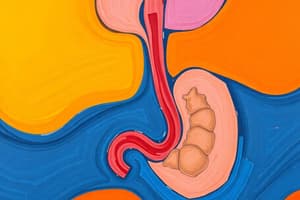Podcast
Questions and Answers
What is the role of parietal cells in the stomach?
What is the role of parietal cells in the stomach?
- They produce bile to assist in digestion.
- They protect the stomach lining from toxins.
- They help in the absorption of nutrients.
- They secrete intrinsic factor and gastric acid. (correct)
What is a consequence of chronic gastritis related to glandular changes?
What is a consequence of chronic gastritis related to glandular changes?
- The glands begin to secrete increased amounts of intrinsic factor.
- Epithelial cells undergo hyperplasia leading to cyst formation.
- Glands become hypertrophic and produce excess acid.
- The epithelium undergoes metaplasia to acquire a more intestinal type. (correct)
Which factor is most associated with the long-term malignancy potential in gastritis?
Which factor is most associated with the long-term malignancy potential in gastritis?
- Infection with H. Pylori and its associated toxins. (correct)
- Exposure to nonsteroidal anti-inflammatory drugs (NSAIDs).
- Excessive alcohol consumption.
- Increased production of gastrin from the antrum.
How does the CagA complex of H. Pylori affect gastric epithelial cells?
How does the CagA complex of H. Pylori affect gastric epithelial cells?
Which of the following is NOT a known cause of increased gastrin production in gastric inflammation?
Which of the following is NOT a known cause of increased gastrin production in gastric inflammation?
What condition is characterized by progressive dysphagia with no heartburn in elderly patients?
What condition is characterized by progressive dysphagia with no heartburn in elderly patients?
Which condition is characterized by a significant reduction in intrinsic factor leading to B12 deficiency?
Which condition is characterized by a significant reduction in intrinsic factor leading to B12 deficiency?
What is a key diagnostic tool used to identify esophageal motility disorders?
What is a key diagnostic tool used to identify esophageal motility disorders?
Which of the following conditions can cause intermittent dysphagia associated with chest pain?
Which of the following conditions can cause intermittent dysphagia associated with chest pain?
Which category of esophagitis is primarily caused by acid reflux?
Which category of esophagitis is primarily caused by acid reflux?
Which condition is most commonly associated with the presence of anti-Sci70 antibodies?
Which condition is most commonly associated with the presence of anti-Sci70 antibodies?
What is the primary management approach for severe cases of esophageal spasms?
What is the primary management approach for severe cases of esophageal spasms?
What is the most common infectious cause of gastritis?
What is the most common infectious cause of gastritis?
Which of the following is a treatment option for eosinophilic esophagitis?
Which of the following is a treatment option for eosinophilic esophagitis?
Which type of esophageal cancer is primarily linked to Barrett’s metaplasia?
Which type of esophageal cancer is primarily linked to Barrett’s metaplasia?
Which symptom is NOT typically associated with achalasia?
Which symptom is NOT typically associated with achalasia?
What is a major complication associated with esophagitis?
What is a major complication associated with esophagitis?
What is a common consequence of untreated peptic ulcer disease?
What is a common consequence of untreated peptic ulcer disease?
In which demographic does eosinophilic esophagitis most commonly occur?
In which demographic does eosinophilic esophagitis most commonly occur?
Which neurological condition is associated with oropharyngeal dysphagia?
Which neurological condition is associated with oropharyngeal dysphagia?
Which of the following is a classic presenting symptom of esophageal carcinoma?
Which of the following is a classic presenting symptom of esophageal carcinoma?
Which of the following statements about Boerhaave’s syndrome is correct?
Which of the following statements about Boerhaave’s syndrome is correct?
What are the main risk factors for esophageal carcinoma?
What are the main risk factors for esophageal carcinoma?
What is a significant risk factor for gastric ulcers?
What is a significant risk factor for gastric ulcers?
Which condition is characterized by a small tumor that produces excessive gastrin?
Which condition is characterized by a small tumor that produces excessive gastrin?
Which demographic is more likely to develop gastric cancer?
Which demographic is more likely to develop gastric cancer?
What symptom is commonly associated with gastric ulcers following a meal?
What symptom is commonly associated with gastric ulcers following a meal?
Which substance is associated with increased risk of gastric cancer?
Which substance is associated with increased risk of gastric cancer?
What role does mucous bicarbonate play in the stomach?
What role does mucous bicarbonate play in the stomach?
What factor does NOT contribute to the risk of gastric ulcers?
What factor does NOT contribute to the risk of gastric ulcers?
Which type of gastric cancer is indicated by a thick wall and infiltrative nature, commonly identified as 'leather bottle' appearance?
Which type of gastric cancer is indicated by a thick wall and infiltrative nature, commonly identified as 'leather bottle' appearance?
Study Notes
Dysphagia
- Dysphagia categorized into solid food only and solids and liquids.
- Solid food only:
- Intermittent: Esophageal ring causes.
- Progressive:
- With heartburn: Peptic stricture.
- Without heartburn: Linked to old age or carcinoma.
- Solids and liquids:
- Intermittent: Chest pain associated with Diffuse Esophageal Spasm (DES).
- Progressive:
- With heartburn: Scleroderma.
- Without heartburn: Nocturnal symptoms indicate achalasia, a condition of lack of relaxation.
- Mechanical causes of dysphagia include benign/malignant strictures, esophageal webs/rings, diverticula, hernias, and inflammatory conditions.
- Functional causes include achalasia, scleroderma, and DES.
- Oropharyngeal dysphagia often results from neurological deficits (e.g., ALS, diabetic neuropathy, MS).
Esophagitis
- Inflammation of the esophageal mucosa categorized as:
- GERD: Acid-related damage.
- Medication-associated: Certain antibiotics and NSAIDs.
- Infectious: Cytomegalovirus, herpes, candidiasis.
- Eosinophilic: Antigen sensitivity, notably in young white males.
- Symptoms include painful swallowing (odynophagia), dysphagia, heartburn, and retrosternal pain.
- Diagnosis confirmed via endoscopy.
- Management tactics vary based on cause including:
- GERD: Reflux treatments.
- Medication: Adjustments.
- Infectious: Antimicrobial therapy.
- Eosinophilic: PPIs, steroids.
- Major complications include recurrence leading to esophageal stricture.
Gastritis
- Inflammation of gastric mucosa, often infectious; Helicobacter Pylori is the most common cause.
- Autoimmune gastritis more prevalent in women; other less common causes include Crohn's, IBS, and ischemic conditions.
- Primarily affects the antrum of the stomach, notably impacting mucus cells.
- Causes encompass:
- Increased gastrin production.
- Epithelial cell injury.
- NSAIDs, alcohol, autoimmune diseases.
- H. pylori can create toxins leading to cell injury.
- Acute gastritis characterized by inflammation and increased acid secretion.
- Chronic gastritis leads to gland atrophy and metaplasia, decreasing acid and intrinsic factor production, increasing risk for cancer and MALT lymphoma.
- Symptoms include heartburn, iron deficiency, and cognitive decline.
- Diagnosis aided by CBC, stool tests, endoscopy, and breath tests.
- Treatment involves avoiding irritants, PPIs, and antibiotics as needed.
Esophageal Motility Disorders
- Disorders like diffuse spasm, scleroderma, and achalasia cause esophageal dysphagia.
- Spasms characterized by hyperdynamic, non-propulsive contractions due to various factors like decreased nitric oxide and inflammation.
- Presentation can vary from asymptomatic to intermittent dysphagia or chest pain, exacerbated by temperature changes.
- Diagnosis through manometry showing increased pressure contractions and barium swallow displaying corkscrew patterns.
- Management options include peppermint oil, calcium channel blockers, PPIs, and localized botulinum injections for severe cases.
Scleroderma
- An autoimmune disorder causing esophageal atrophy, scarring, and decreased lower esophageal tone.
- Characterized by diminished peristalsis and massive reflux.
- Diagnosed with AntiSci70 test, where 95% of CREST patients test positive.
- Includes features like calcinosis, Raynaud's, esophageal dysmotility, sclerodactyly, and telangiectasia.
- Treatment involves immunosuppression, PPIs, endoscopic dilation for strictures, and surgical fundoplication if necessary.
Achalasia
- Characterized by degeneration of ganglion cells, leading to esophageal dysfunction and diminished peristalsis.
- Lower esophageal sphincter fails to relax, leading to megacolon and regurgitation of undigested food.
- Diagnosed via barium swallow showing "bird beak sign."
- Management includes muscle fiber stretching techniques like balloon dilation, botulinum toxin, oral nitrates, and calcium blockers.
Esophageal Carcinoma
- Eighth most prevalent cancer; sixth leading cause of cancer death, more common in males.
- Two primary types:
- Squamous cell carcinoma: prevalent globally, linked to diet.
- Adenocarcinoma: more common in the U.S., associated with Barrett’s esophagus.
- Symptoms: bleeding, dysphagia, significant weight loss, iron deficiency, and pain (odynophagia).
- Diagnosis involves barium swallow, endoscopy, and biopsy.
- Treatment focuses on early detection for surgical resection, chemotherapy, and palliative care options.
Gastroesophageal Reflux Disease (GERD)
- Symptoms: esophagitis, chest pain, heartburn, regurgitation, cough, dysphagia.
- Water brash due to hypersalivation from gastric contents reflux.
- Diagnostic methods include symptom evaluations and potential endoscopy if treatment fails.
- 24-hour pH monitoring can indicate acid reflux.
Esophageal Tears and Perforations
- Includes Mallory-Weiss Syndrome and Boerhaave’s Syndrome; more common in males.
- Often linked to alcohol use; tears account for 10-15% of upper GI bleeds.
- Symptoms can range from asymptomatic to chest/epigastric pain, often post-vomiting.
- Diagnosis often confirmed through symptoms and endoscopy.
- Management involves fluids, transfusion, and specialized tubes for pressure.
Peptic Ulcer Disease
- Most ulcers occur in the duodenum; major cause is H. pylori infection.
- Other factors: NSAIDs, corticosteroids, smoking, and chronic diseases.
- Gastric ulcers occur primarily in the lesser curvature of the stomach, while duodenal ulcers are more common.
- Symptoms include epigastric pain, nausea, and possible occult bleeding.
- Diagnosis through EGD can reveal ulcers; treatment includes lifestyle modifications, PPIs, and antibiotics.
Gastric Cancer
- Third most common cancer death, particularly prevalent in Eastern Asia and Eastern Europe.
- Associated risk factors: nitrosamines, genetics, H. pylori, longstanding gastritis.
- Intestinal gastric carcinoma presents as nodular; diffuse is infiltrative with poor prognosis.
- Presentation includes epigastric discomfort, nausea, weight loss, and potential hematemesis.
Studying That Suits You
Use AI to generate personalized quizzes and flashcards to suit your learning preferences.
Description
This quiz covers the different categories of dysphagia related to both solid food and liquids. It explores causes ranging from esophageal rings to conditions like achalasia and scleroderma. Understanding these classifications is crucial for diagnosing and managing dysphagia effectively.




